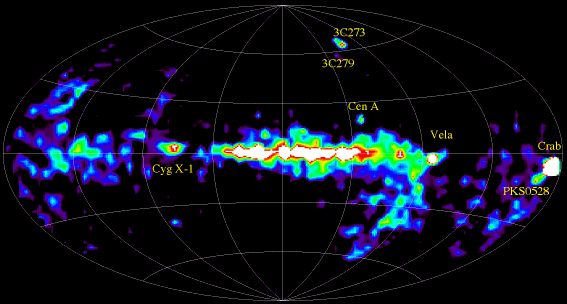COMPTEL Gamma-Ray Source Catalog

Click image for larger view
A list of the 63 gamma-ray sources detected by the Imaging Compton Telecope (COMPTEL) on NASA's Compton Gamma Ray Observatory has been released as the COMPTEL source catalog. The daily operations of the COMPTEL instrument have been overseen for the past eight years by the University of New Hampshire's Space Science Center.
"The catalog represents several years of data analysis," says Mark McConnell, UNH associate research professor and member of the COMPTEL team, "and yet it underscores how little we know about the universe as seen in the gamma-ray part of the spectrum."
The COMPTEL instrument, partially built at UNH and launched aboard the shuttle Atlantis in 1991, observes a bandwidth of light 10-times wider than that covered by optical telescopes and a million times more energetic. All commands sent to the instrument originate at UNH.
Gamma rays occupy the highest energy range in the electromagnetic spectrum, well beyond visible light, ultraviolet and X-rays. They are produced by extreme forces of energy and by atomic decay. The COMPTEL catalog comprises 63 gamma-ray sources. Thirty-two of these are steady sources, such as neutron stars and black hole candidates; the remaining 31 are mysterious gamma-ray bursts, which outshine the entire universe before fading within a few seconds.
A major priority for high-energy astrophysicists has been to isolate and understand gamma-ray bursts, which appear without warning somewhere in the observable universe about three times a day. The COMPTEL team at UNH has since written software to allow COMPTEL to zero-in on the bursts within the few seconds they are going off. The software connects COMPTEL to the Gamma-Ray Burst Coordinates Network, a NASA-operated network that notifies dozens of telescopes about bursts in real-time.
COMPTEL, one of four instruments aboard CGRO, captures a part of the electromagnetic spectrum that has been previously unexplored, and it fills a gap between more easily detectable lower- and higher-energy gamma rays. This sliver of the spectrum contains crucial information about light sources that are "invisible" to any other telescope.
Two unique sources that appear in the COMPTEL energy range are isotopes of titanium (Ti-44) and aluminum (Al-26), which are both produced in supernova explosions. Ti-44 has a half-life of 60 years; Al-26 has a half-life of 700,000 years. The detection of decaying titanium, therefore, can lead to the discovery of young supernova remnants; decaying aluminum can point to ancient supernova remnants. Both metals, in fact, played a role in COMPTEL's discovery of a supernova remnant now called GRO/RX J0852, which was as bright as the moon when it exploded 700 years ago yet somehow remained undocumented until last year.
Other objects in COMPTEL's range include pulsars and active galactic nuclei (AGN), which are thought to host massive black holes of one million to one billion times the mass of the Sun. The most massive AGN often display their maximum luminosity in the COMPTEL energy range, making gamma-ray observations crucial for understanding these objects. While the other instruments aboard CGRO have now produced several catalogs since the satellite's launching in 1991, the COMPTEL catalog was eight years in the making. This was due to the unique physics of COMPTEL's observable energy band and the mechanics of the instrument itself. COMPTEL had greater difficulty discerning between source and background gamma radiation. Thus, careful modeling of background energy was needed before the COMPTEL team could isolate distinct gamma-ray sources for the catalog.
Unlike optical light and X-rays, gamma rays cannot be captured and reflected in mirrors. The high-energy photons would pass right through such a device. COMPTEL must utilize a process called Compton scattering, where a gamma ray strikes an electron and loses energy, similar to a cue ball striking an eight ball. COMPTEL has two sets of detectors that scatter gamma rays -- that is, the detectors act like billiard balls. The detectors are aligned one below the other. The gamma ray passes through, striking an electron in one detector and then another electron in the second detector. By combining measurements of the loss of energy and the change of trajectory, the COMPTEL scientists can construct a likelihood map of the probable gamma-ray source location.
The COMPTEL data analysis is performed jointly by Max Planck Institute for Extraterrestrial Physics, which also helped build the instrument; NASA's Goddard Space Flight Center, which controls day-to-day operations of the entire Observatory; the Space Research Organization of the Netherlands in Utrecht, Netherlands; the Space Science Department of the Astrophysics Division of ESA/ESTEC in Noordwijk, Netherlands; and the University of New Hampshire.
If you have a question about CGRO, please contact us via the Feedback form.

